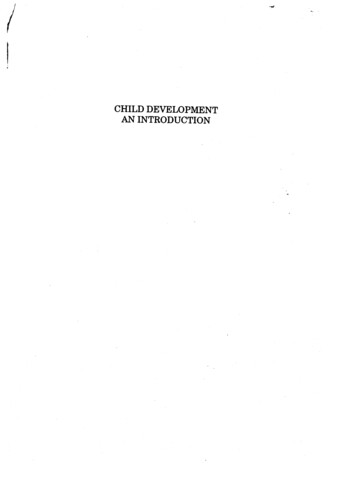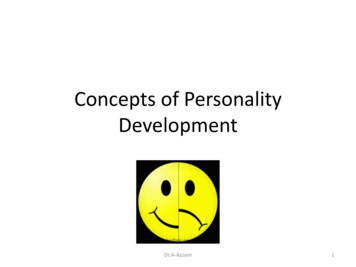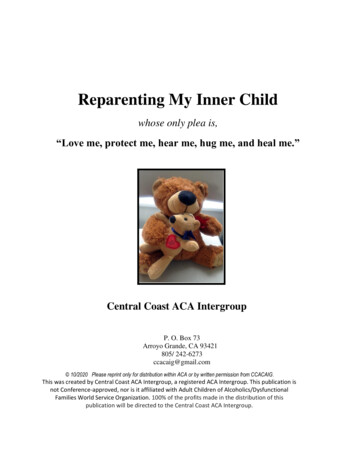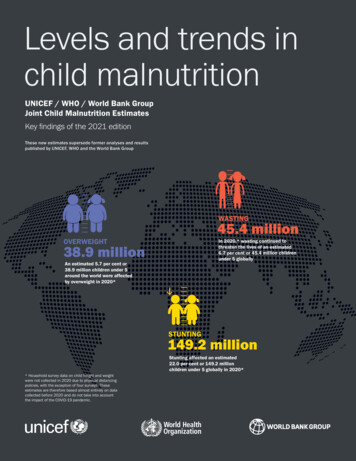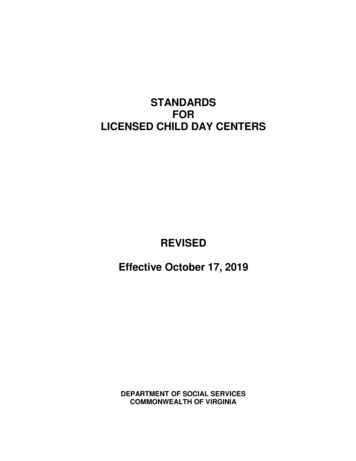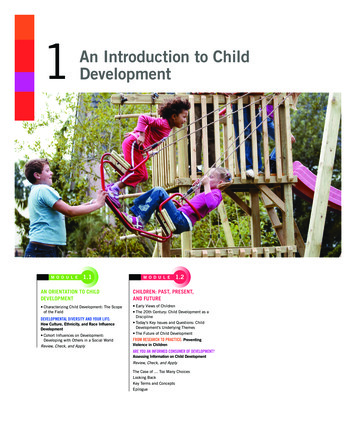
Transcription
1M o d u l eAn Introduction to ChildDevelopment1.1M o d u l e1.2An Orientation to ChildDevelopmentChildren: Past, Present,and Future Characterizing Child Development: The Scopeof the Field Early Views of Children The 20th Century: Child Development as aDiscipline Today’s Key Issues and Questions: ChildDevelopment’s Underlying Themes The Future of Child DevelopmentDevelopmental Diversity and your life:How Culture, Ethnicity, and Race InfluenceDevelopment Cohort Influences on Development:Developing with Others in a Social WorldReview, Check, and ApplyFrom Research to Practice: PreventingViolence in Childrenare you an Informed Consumer of Development?Assessing Information on Child DevelopmentReview, Check, and ApplyThe Case of Too Many ChoicesLooking BackKey Terms and ConceptsEpilogueM01 FELD3496 01 SE C01.indd 224/05/13 2:40 PM
Learning ObjectivesModule 1.1Prologue: Conceptions,LO1 What is child development?LO2 What is the scope of the field ofOld and Newchild development?She was famous from the moment she was born. But it wasn’t who she was thatmade others curious about her: It was how she was conceived.LO3 What are major societal influencesthat determine development?Louise Brown, who is now in her mid-30s, has always been known as theworld’s first “test tube baby.” She was born by in vitro fertilization (IVF), a proce-Module 1.2dure in which fertilization of a mother’s egg by a father’s sperm takes place outsideLO4 How have views of childhoodof the mother’s body.changed historically?Louise was a preschooler when her parents told her about how she was conceived, and throughout her childhood she was bombarded with questions. It becameroutine to explain to her classmates that she in fact was not born in a laboratory.As a child, Louise sometimes felt isolated. “I thought it was something peculiarto me,” she recalled. But as she grew older, her isolation declined as more and moreLO5 What are the key issues andquestions in the field of childdevelopment?LO6 What is the future of childdevelopment likely to hold?children were born in the same manner.Today, Louise is hardlyisolated. More than 1.5 million babies have been bornusing the procedure, whichhas become almost routine.And at the age of 28, Louise became a mother herself, giving birth to a babyboy named Cameron— conceived, by the way, in theold-fashioned way (Moreton,2007; Hastings, 2010).Louise Brown and son.L o o k i n g A h e adLouise Brown’s conception may have been novel, but her development, from infancy onward, has followed predictable patterns. While the specifics of our development vary—some encounter economic deprivation or live in war-torn territories; others contend withfamily issues such as divorce and stepparents—the broad strokes of the developmentset in motion in that test tube three decades ago are remarkably similar for all of us.Louise Brown’s conception in the lab is just one of the brave new worlds of the21st century. Issues ranging from cloning to the consequences of poverty on development to the effects of culture and race raise significant developmental concerns. Underlying these are more fundamental issues: How do children develop physically? How(continued)3M01 FELD3496 01 SE C01.indd 324/05/13 2:41 PM
4 C hapter 1 An Introduction to Child Developmentdoes their understanding of the world grow and change over time? And how do our personalitiesand social world develop as we move from birth through adolescence?These questions, and many others we’ll encounter throughout this book, are central to thefield of child development. Consider, for example, the range of approaches that different specialists in child development might take when considering the story of Louise Brown: Child development researchers who investigate behavior at the level of biological processesmight determine if Louise’s physical functioning before her birth was affected by her conception outside the womb. Specialists in child development who study genetics might examine how the biological endowment from Louise’s parents affects her later behavior. For child development specialists who investigate the ways thinking changes during childhood, Louise’s life might be examined in terms of how her understanding of the nature ofher conception changed as she grew older. Other researchers in child development who focus on physical growth might considerwhether her growth rate differed from children conceived more traditionally. Child development experts who specialize in the social world of children might look at theways that Louise interacted with other children and the kinds of friendships she developed.Although their interests take many forms, these specialists in child development share oneconcern: understanding the growth and change that occur during the course of childhood andadolescence. Taking many differing approaches, developmentalists study how both our biological inheritance from our parents and the environment in which we live jointly affect our behavior.Some researchers in child development focus on explaining how our genetic background candetermine not only how we look but also how we behave and how we relate to others—that is,matters of personality. These professionals explore ways to identify how much of our potential ashuman beings is provided—or limited—by heredity. Other child development specialists look tothe environment in which we are raised, exploring ways in which our lives are shaped by the worldthat we encounter. They investigate the extent to which we are shaped by our early environmentsand how our current circumstances influence our behavior in both subtle and obvious ways.Whether they focus on heredity or environment, all child development specialists hope thattheir work will ultimately inform and support the efforts of professionals whose careers are devoted to improving the lives of children. Practitioners in fields ranging from education to healthcare to social work draw on the findings of child development researchers, using those findingsto advance children’s welfare.In this chapter, we orient ourselves to the field of child development. We begin with a discussion of the scope of the discipline, illustrating the wide array of topics it covers and the rangeof ages it examines, from the moment of conception through the end of adolescence. We alsosurvey the foundations of the field and examine the key issues and questions that underlie childdevelopment. Finally, we consider where the child development field is likely to go in the future.M o d u l e1.1An Orientation to Child DevelopmentLO 1-1 What is child development?LO 1-2 What is the scope of the field of child development?LO 1-3 What are major societal influences that determine development?M01 FELD3496 01 SE C01.indd 424/05/13 2:41 PM
Chapter 1 An Introduction to Child Development 5Have you ever wondered how it is possible that an infant tightly grips your finger with tiny,perfectly formed hands? Or marveled at how a preschooler methodically draws a picture? Orpondered the way an adolescent can make involved decisions about whom to invite to a partyor the ethics of downloading music files?If you’ve ever wondered about such things, you are asking the kinds of questions thatscientists in the field of child development pose. Child development is the scientific study ofthe patterns of growth, change, and stability that occur from conception through adolescence.Although the definition of the field seems straightforward, the simplicity is somewhatmisleading. To understand what child development is actually about, we need to look underneath the various parts of the definition.In its study of growth, change, and stability, child development takes a scientific approach. Like members of other scientific disciplines, researchers in child development testtheir assumptions about the nature and course of human development by applying scientific methods. As we’ll see in the next chapter, they develop theories about development,and they use methodical, scientific techniques to validate the accuracy of their assumptionssystematically.Child development focuses on human development. Although there are some developmentalists who study the course of development in nonhuman species, the vast majorityexamine growth and change in people. Some seek to understand universal principles of development, while others focus on how cultural, racial, and ethnic differences affect the course ofdevelopment. Still others aim to understand the unique aspects of individuals, looking at thetraits and characteristics that differentiate one person from another. Regardless of approach,however, all child developmentalists view development as a continuing process throughoutchildhood and adolescence.As developmental specialists focus on the ways people change and grow during theirlives, they also consider stability in children’s and adolescents’ lives. They ask in which areasand in what periods people show change and growth and when and how their behavior revealsconsistency and continuity with prior behavior.Finally, although child development focuses on childhood and adolescence, the processof development persists throughout every part of people’s lives, beginning with the momentof conception and continuing until death. Developmental specialists assume that in someways people continue to grow and change right up to the end of their lives, while in otherrespects their behavior remains stable. In other words, developmentalists believe that no particular, single period of life governs all development. Instead, they believe that every periodof life contains the potential for both growth and decline in abilities and that individualsmaintain the capacity for substantial growth and change throughout their lives.Characterizing Child Development: The Scope of the FieldClearly, the definition of child development is broad and the scope of the field is extensive.Consequently, professionals in child development cover several quite diverse areas, and atypical developmentalist will specialize in both a topical area and age range.Topical Areas in Child Development. The field of child development includes threemajor topics or approaches: Physical development Cognitive development Social and personality developmentA child developmentalist might specialize in one of these topical areas. For example,some developmentalists focus on physical development, examining the ways in which thebody’s makeup—the brain, nervous system, muscles, and senses and the need for food, drink,and sleep—helps determine behavior. For example, one specialist in physical developmentmight examine the effects of malnutrition on the pace of growth in children, while anothermight look at how an athlete’s physical performance changes during adolescence.Other developmental specialists examine cognitive development, seeking to understand how growth and change in intellectual capabilities influence a person’sM01 FELD3496 01 SE C01.indd 5child development The field that involvesthe scientific study of the patterns of growth,change, and stability that occur from conception through adolescencephysical development Development involving the body’s physical makeup, including thebrain, nervous system, muscles, and sensesand the need for food, drink, and sleepcognitive development Development involving the ways that growth and change inintellectual capabilities influence a person’sbehavior24/05/13 2:41 PM
6 C hapter 1 An Introduction to Child Developmentbehavior. Cognitive developmentalists examine learning, memory, problem solving, and intelligence. For example, specialists in cognitive development mightwant to see how problem-solving changes over the course of childhood or if cultural differences exist in the ways people explain the reasons for their academicsuccesses and failures. They would also be interested in how a person who experiences significant or traumatic events early in life remembers them later in life(Alibali, Phillips, & Fischer, 2009; Dumka et al., 2009; van Wesel et al., 2011).Finally, some developmental specialists focus on personality and social development. Personality development is the study of stability and change in the enduring characteristics that differentiate one person from another. Social development is the way inwhich individuals’ interactions with others and their social relationships grow, change,and remain stable over the course of life. A developmentalist interested in personalitydevelopment might ask whether there are stable, enduring personality traits throughoutthe life span, while a specialist in social development might examine the effects of racism, poverty, or divorce on development (Lansford, 2009; Vélez et al., 2011; Carter et al.,2011). These three major topic areas—physical, cognitive, and social and personality development—are summarized in Table 1-1.This wedding of two children in India is an example ofhow cultural factors play a significant role in determiningthe age when a particular event is likely to occur.Age Ranges and Individual Differences. As they specialize in chosen topicalareas, child developmentalists typically look at particular age ranges. They usually divide childhood and adolescence into broad age ranges: the prenatal period (the periodfrom conception to birth), infancy and toddlerhood (birth to age 3), the preschool period(ages 3 to 6), middle childhood (ages 6 to 12), and adolescence (ages 12 to 20).It’s important to keep in mind that these broad periods—which are largely accepted bychild developmentalists—are social constructions. A social construction is a shared notionof reality, one that is widely accepted but is a function of society and culture at a given time.Table 1-1 Approaches to Child Developmentpersonality development Developmentinvolving the ways that the enduring characteristics that differentiate one person fromanother change over the life spansocial development The way in which individuals’ interactions with others and theirsocial relationships grow, change, and remainstable over the course of lifeM01 FELD3496 01 SE C01.indd 6OrientationDefining CharacteristicsExamples of Questions Asked*PhysicalDevelopmentExamines how brain,nervous system, muscles,sensory capabilities, andneeds for food, drink, andsleep affect behaviorWhat determines the sex of a child? (3)What are the long-term consequences ofpremature birth? (4)What are the benefits of breastfeeding? (4)What are the consequences of early or late sexualmaturation? (5)CognitiveDevelopmentEmphasizes intellectualabilities, includinglearning, memory, languagedevelopment, problemsolving, and intelligenceWhat are the earliest memories that can berecalled from infancy? (7)What are the consequences of watchingtelevision? (15)Are there benefits to bilingualism? (8)Are there ethnic and racial differences inintelligence? (9)How does an adolescent’s egocentrism affect hisor her view of the world? (6)Personalityand SocialDevelopmentExamines enduringcharacteristics thatdifferentiate one personfrom another and howinteractions with others andsocial relationships grow andchange over the life spanDo newborns respond differently to their mothersthan to others? (4)What is the best procedure for discipliningchildren? (13)When does a sense of gender develop? (12)How can we promote cross-race friendships? (14)What are the causes of adolescent suicide? (10)*Numbers in parenthesis indicate in which chapter the question is addressed.24/05/13 2:41 PM
Chapter 1 An Introduction to Child Development 7Although most child developmentalists accept these broad periods, the age rangesthemselves are in many ways arbitrary. Although some periods have one clear-cut boundary(infancy begins with birth, the preschool period ends with entry into public school, and adolescence starts with sexual maturity), others don’t.For instance, consider the separation between middle childhood and adolescence, whichusually occurs around the age of 12. Because the boundary is based on a biological change,the onset of sexual maturation, which varies greatly from one individual to another, the specific age of entry into adolescence varies from one person to the next.Furthermore, some developmentalists have proposed entirely new developmental periods. For instance, psychologist Jeffrey Arnett argues that adolescence extends into emergingadulthood, a period beginning in the late teenage years and continuing into the mid-20s. During emerging adulthood, people are no longer adolescents, but they haven’t fully taken on theresponsibilities of adulthood. Instead, they are still trying out different identities and engagein self-focused exploration (Schwartz, Côté, & Arnett, 2005; Lamborn & Groh, 2009; Arnett,2010, 2011).In short, there are substantial individual differences in the timing of events in people’slives. In part, this is a biological fact of life: People mature at different rates and reach developmental milestones at different points. However, environmental factors also play a significant role in determining the age at which a particular event is likely to occur. For example, thetypical age at which people develop romantic attachments varies substantially from one culture to another, depending in part on the way that relationships are viewed in a given culture.It is important to keep in mind, then, that when developmental specialists discuss ageranges, they are talking about averages—the times when people, on average, reach particularmilestones. Some children will reach the milestone earlier, some later, and many—in fact,most—will reach it around the time of the average. Such variation becomes noteworthy onlywhen children show substantial deviation from the average. For example, parents whose childbegins to speak at a much later age than average might decide to have their son or daughterevaluated by a speech therapist.Furthermore, as children grow older, they become more likely to deviate from the average and exhibit individual differences. In very young children, a good part of developmental change is genetically determined and unfolds automatically, making development fairlysimilar in different children. But as children age, environmental factors become more potent,leading to greater variability and individual differences as time passes.The Links between Topics and Ages. Each of the broad topical areas of child development—physical, cognitive, and social and personality development—plays a rolethroughout childhood and adolescence. Consequently, some developmental experts focuson physical development during the prenatal period and others on what occurs during adolescence. Some might specialize in social development during the preschool years, whileothers look at social relationships in middle childhood. And still others might take a broaderapproach, looking at cognitive development through every period of childhood and adolescence (and beyond).The variety of topical areas and age ranges studied within the field of child developmentmeans that specialists from many diverse backgrounds and areas of expertise consider themselves child developmentalists. Psychologists who study behavior and mental processes, educational researchers, geneticists, and physicians are only some of the people who specializeand conduct research in child development. Furthermore, developmentalists work in a varietyof settings, including university departments of psychology, education, human development,and medicine, as well as nonacademic settings as varied as human service agencies and childcare centers.The diversity of specialists working under the broad umbrella of child developmentbrings a variety of perspectives and intellectual richness to the field of child development. Inaddition, it permits the research findings of the field to be used by practitioners in a wide array of applied professions. Teachers, nurses, social workers, child care providers, and socialpolicy experts all rely on the findings of child development to make decisions about how toimprove children’s welfare.M01 FELD3496 01 SE C01.indd 724/05/13 2:41 PM
8 C hapter 1 An Introduction to Child DevelopmentDevelopmental Diversity and Your LifeHow Culture, Ethnicity, and Race Influence DevelopmentMayan mothers in Central America are certain that almost constant contact between themselvesand their infant children is necessary for good parenting, and they are physically upset if contactis not possible. They are shocked when they see a North American mother lay her infant down, andthey attribute the baby’s crying to the poor parenting of the North American. (Morelli et al., 1992)What are we to make of the two views of parenting expressed above? Is one right and the other wrong?Probably not, if we take into consideration the cultural context in which the mothers are operating.In fact, different cultures and subcultures have their own views of appropriate and inappropriate childrearing, just as they have different developmental goals for children (Tolchinsky, 2003; Feldman &Masalha, 2007; Huijbregts et al., 2009).Specialists in child development must take into consideration broad cultural factors. For example,as we’ll discuss further in Chapter 11, children growing up in Asian societies tend to have a collectivistic orientation, focusing on the interdependence among members of society. In contrast, childrenin Western societies are more likely to have an individualistic orientation in which they concentrateon the uniqueness of the individual.Similarly, child developmentalists must also take into account ethnic, racial, socioeconomic, andgender differences if they are to achieve an understanding of how people change and grow throughout the life span. If these specialists succeed in doing so, not only can they achieve a better understanding of human development, but they may also be able to derive more precise applications forimproving the human social condition.Efforts to understand how diversity affects development have been hindered by difficulties infinding an appropriate vocabulary. For example, members of the research community—as well associety at large—have sometimes used terms such as race and ethnic group in inappropriate ways.Race is a biological concept, which should be employed to refer to classifications based on physicaland structural characteristics of species. In contrast, ethnic group and ethnicity are broader terms,referring to cultural background, nationality, religion, and language.The concept of race has proven particularly problematic. Although it formally refers to biological factors, race has taken on substantially more meanings—many of them inappropriate—thatrange from skin color to religion to culture. Moreover, the concept of race is exceedingly imprecise; depending on how it is defined, there are between 3 and 300 races, and no race is genetically distinct. The fact that 99.9% of humans’ genetic makeup is identical in all humans makes the questionof race seem insignificant (Smedley & Smedley, 2005; Coleman, 2011; Fish, 2011).In addition, there is little agreement about which names best reflect different races and ethnicgroups. Should the term African American—which has geographical and cultural implications—bepreferred over black, which focuses primarily on skin color? Is Native American preferable to Indian?Is Hispanic more appropriate than Latino? And how can researchers accurately categorize peoplewith multiethnic backgrounds? The choice of category has important implications for the validityand usefulness of research. The choice even has political implications. For example, the decisionThe face of the United States is changing as the proportion of children from different backgrounds is increasing.M01 FELD3496 01 SE C01.indd 824/05/13 2:41 PM
Chapter 1 An Introduction to Child Development 9to permit people to identify themselves as “multiracial” on U.S. government forms and in the 2000U.S. Census initially was highly controversial, although it is now routine (Perlmann & Waters, 2002;Saulny, 2011).As the proportion of minorities in U.S. society continues to increase, it becomes crucial to takethe complex issues associated with human diversity into account to fully understand development.In fact, it is only by looking for similarities and differences among various ethnic, cultural, and racialgroups that developmental researchers can distinguish principles of development that are universalfrom ones that are culturally determined. In the years ahead, then, it is likely that child developmentwill move from a discipline that primarily focuses on children with North American and Europeanbackgrounds to one that encompasses the development of children around the globe (Matsumoto &Yoo, 2006; Wardle, 2007; Kloep et al., 2009). Watch the Video Chi Hae: Raising anEleven-Month-Old in MyPsychLab.Cohort Influences on Development:Developing with Others in a Social WorldBob, born in 1947, is a baby boomer. He was born soon after the end of World War II, whenan enormous bulge in the birthrate occurred as soldiers returned to the United States fromoverseas. He was an adolescent at the height of the civil rights movement and the beginningof protests against the Vietnam War. His mother, Leah, was born in 1922; she is part of thegeneration that passed its childhood and teenage years in the shadow of the Great Depression.Bob’s son, Jon, was born in 1975. Now building a career after graduating from college andstarting his own family, he is a member of what has been called Generation X. Jon’s youngersister, Sarah, who was born in 1982, is part of the next generation, which sociologists havecalled the Millennial Generation.These people are in part products of the social times in which they live. Each belongs toa particular cohort, a group of people born at around the same time in the same place. SuchFrom anmajor social events as wars, economic upturns and depressions, famines, and epidemics (sucheducator’sas the one due to the AIDS virus) work similar influences on members of a particular cohortperspective:(Mitchell, 2002; Dittmann, 2005).How would a student’s cohort memCohort effects provide an example of history-graded influences, which are biologicalbership affect his or her readiness forand environmental influences associated with a particular historical moment. For instance,school? For example, what would be thechildren who lived in New York City during the 9/11 terrorist attack on the World Tradebenefits and drawbacks of coming from aCenter experienced shared biological and environmental challenges due the attack. Theircohort in which Internet use was routine, development is bound to be affected by this normative history-graded event (Bonanno, Galea,compared with earlier cohorts prior to the Bucciarelli, & Vlahov, 2006; Laugharne, Janca, & Widiger, 2007; Mani & Plunkett, 2011).appearance of the Internet?In contrast, age-graded influences are biological and environmental influences that aresimilar for individuals in a particular age group, regardless of when or where they are raised.For example, biological events such as puberty and menopause are universal events that occohort A group of people born at around thecur at relatively the same time throughout all societies. Similarly, a sociocultural event suchsame time in the same placeas entry into formal education can be considered a normative age-graded influence because itoccurs in most cultures around age 6.Development is also affected by sociocultural-graded influences, whichinclude ethnicity, social class, subcultural membership, and other factors. Forexample, sociocultural-graded influences will be considerably different for immigrant children who speak English as a second language than for childrenborn in the United States who speak English as their first language (Rose et al.,2003; Kärtner et al., 2011).Finally, non-normative life events also influence development. Non- normativelife events are specific, atypical events that occur in a particular person’s life at atime when such events do not happen to most people. For instance, the experienceof Louise Brown, who grew up with the knowledge that she was the first personto be conceived using in vitro fertilization, constitutes a non-normative life event.In addition, children can create their own non-normative life events. For instance,a high school girl who enters and wins a national science competition produces Society’s view of childhood and what is appropriate to ask ofa non-normative life event for herself. In a sense, she is actively constructing her children has changed through the ages. These children workedown environment, thereby participating in her own development.full time in mines in the early 1900s.M01 FELD3496 01 SE C01.indd 924/05/13 2:41 PM
10 C hapt e r 1 An Introduction to Child DevelopmentReview, Check, and ApplyReview1. The field of child development involves the scientific study of the ways in which childrengrow and develop from the time before birth to the end of adolescence.2. Child development examines physical, cognitive, and social and personality developmentacross broad age ranges and across individuals.3. Development is affected by race, ethnicity, gender, and culture and is sensitive to cohorteffects, age-graded influences, sociocultural influences, and non-normative life events.Check1. Child development takes a scientific approach to development, and it considersas well as change, in the lives of children and adolescents.2. The field of child development includes three major topics or approaches: physical development,development, and social and personality development.3. Specialists in child development must take into consideration broadfactors and account for ethnic, racial, socioeconomic, and gender differences if they are tounderstand how people change and grow throughout the life span.4. Major social events have similar influences on members of
Characterizing Child Development: the Scope of the Field Clearly, the definition of child development is broad and the scope of the field is extensive. Consequently, professionals in child development cover several quite diverse areas, and a typical developmental



